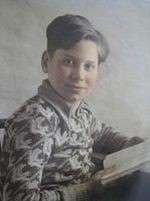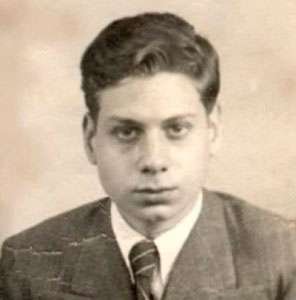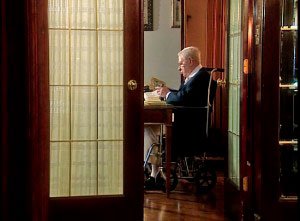Childhood and adolescence:
Fernando Rielo was born in Madrid, Spain, on August 28, 1923. His parents, Don Vivero and Doña Pilar Pardal Espadero, had a family of eight children, five of whom survived the vicissitudes of the times: (in order of birth) Enrique, FERNANDO, Pepe, Pilar, and Isabel. A singular providence marked Fernando’s life from his birth, given that on two occasions, while still a tender infant, he was at the brink of death.
The key to his entire existence was the presence of his Heavenly Father. With Him he learned to pray and even to familiarize himself with the first letters of the alphabet. Fernando played games with Him and went to and returned from school with Him. While his behavior among his friends was that of a normal child, his spirit always looked heavenward. Whatever situation came his way, he turned it into an act of love for God.
On May 21, 1936, in the context of growing social and political unrest in Spain, which led two years later to the Civil War, Fernando, at age twelve, made his First Communion “amid uprisings and rifles.”

He and his family were persecuted for the faith, and Fernando was even about to offer his life when recognized as a Christian by a militant. He would have gladly died for Christ; his passion for martyrdom was awakened on reading the work Fabiola. Indeed, in ardent love for Christ, he made an incision in his hand and wrote with his own blood the following promise: “I promise You, Lord, to live and transmit the Gospel with the sacrifice of my life and my reputation, faithful to the greatest testimony of love: To die for You.”
At that time in his life, he grew in devotion to the Virgin Mary and St. Joseph. He would recite with uncontainable emotion the Salve Regina and the Tantum Ergo at the Church of the Miraculous Medal of the Blessed Virgin of the Pauline Fathers in Madrid.
Some years later, while participating in a youth camp in the lovely countryside of the Sierra Guadarrama (Segovia), he received the message of holiness on the morning of August 28, 1939. There, among many pine trees, the majestic voice of the eternal Father pronounced these words: “My son, be holy, as I, your Heavenly Father, am holy.” From that moment he, without vacillating, intensified his actions in keeping with his promise to offer his life until the end of his days.
The war occasioned an interruption in his academic studies, but not in his spiritual life. The dramatic moments that he and his family had to undergo—with the loss of their house and furniture, the imprisonment of his older brother, the hunger and misery that wreaked havoc on everyone, together with resulting illnesses—intensified his intimacy with his Heavenly Father.
In 1941, when he was seventeen years old, upon completing his secondary school education at the St. Isidore Institute in Madrid, his father became so gravely ill at that time that both his brother, Pepe, and he had to leave higher studies in order to seek out gainful employment.










!["El mundo puede cambiar desde el corazón"
(Papa Francisco, Encíclica Dilexit Nos)
"El Corazón de Cristo es éxtasis, es salida, es donación, es encuentro. En él nos volvemos capaces de relacionarnos de un modo sano y feliz, y de construir en este mundo el Reino de amor y de justicia. Nuestro corazón unido al de Cristo es capaz de este milagro social.
Tomar en serio el corazón tiene consecuencias sociales. Como enseña el Concilio Vaticano II, «tenemos todos que cambiar nuestros corazones, con los ojos puestos en el orbe entero y en aquellos trabajos que todos juntos podemos llevar a cabo para que nuestra generación mejore». Porque «los desequilibrios que fatigan al mundo moderno están conectados con ese otro desequilibrio fundamental que hunde sus raíces en el corazón humano». [21] Ante los dramas del mundo, el Concilio invita a volver al corazón, explicando que el ser humano «por su interioridad es, en efecto, superior al universo entero; a esta profunda interioridad retorna cuando entra dentro de su corazón, donde Dios le aguarda, escrutador de los corazones (cf. 1 S 16,7; Jr 17,10), y donde él personalmente, bajo la mirada de Dios, decide su propio destino».
Esto no significa confiar excesivamente en nosotros mismos. Tengamos cuidado: advirtamos que nuestro corazón no es autosuficiente; es frágil y está herido. Tiene una dignidad ontológica, pero al mismo tiempo debe buscar una vida más digna. Dice también el Concilio Vaticano II que «el fermento evangélico ha despertado y despierta en el corazón del hombre esta irrefrenable exigencia de la dignidad», aunque para vivir conforme a esa dignidad no nos basta conocer el Evangelio ni cumplir mecánicamente lo que nos manda. Necesitamos el auxilio del amor divino. Acudamos al Corazón de Cristo, ese centro de su ser, que es un horno ardiente de amor divino y humano y es la mayor plenitud que puede alcanzar lo humano. Allí, en ese Corazón es donde nos reconocemos finalmente a nosotros mismos y aprendemos a amar."](https://www.idente.org/wp-content/plugins/instagram-feed/img/placeholder.png)